|
The Germans have historically taken great pride in their selected trades or professions. Often this pride
was expressed by having a personalized stein made, depicting one’s occupation. Even today, in the United
States, we look at one’s chosen trade as an indication of status. When attending a social function and
meeting strangers, one of the first questions asked is, “What do you do?” Your reception often depends
on the answer.
The first trade-related steins date to the 17th century. These Faience steins usually depict the more
common trades such as a butcher, a baker or a blacksmith. The "golden years" for occupational steins
occurred from 1895 through 1914, and ended when WW I suddenly curtailed most stein production. I
consider Occupational and Regimental steins to be cousins, since they share similar characteristics
and both categories are mysterious as to their manufacturers. A wide variety of lids were available
on occupational steins, including a steeple or spiral, a five- or six-sided prism in a modified pyramid
shape, permanently affixed to the top of the lid, or a solid cast figure mounted on top. The thumblift,
like their Regimental cousins, often had representation of the state of origin - the crowned or uncrowned
Prussian Eagle, the rampant lion and scroll of Bavaria and Hesse, or other standard thumblifts of the period.
Occupational steins from the Golden Age almost always display one of three expressions paying tribute
to the craftsman practitioner:
Hoch liebe die trambahn {Fig. 3} - (“Long live the tram railway”)
Hoch lebe das edle handwerk - der buchdrucker {Fig. 4} - Long live the noble handiwork
of the printer.”).
Eher soll die Welt verderben, als vor Durst Eisenbahnsterben
{Fig. 5} - (“The world should come to an end before a Railroad worker should die of thirst”).
Of course,
these verses were easily modified to accommodate any desired occupation. Both Regimentals and Occupational
steins cost from 5 to 7 DM in 1900, although a fancy lid would raise the price. This was a considerable
outlay in those days, but an unbelievable value when looking back more than 100 years.
|
|
|
|
Porcelain occupational steins frequently have a picture in the bottom known as a lithophane. Lithophanes
utilize the translucent property of thin porcelain to create an image. Light shines through the thinner
sections and shadows appear in the denser areas.
Shown below are a few examples of occupations that might be discovered on an Occupational stein.
|
|
The fact that Mettlach, a premier stein manufacturer, made two large series of steins, each having a total
of 12 steins, further attests to the importance placed on one's chosen livelihood. The Mettlach,
Professional Series 2001 {Fig. 1} - (Mold numbers - 2001A through L (no "J")) and The Trade Series
(blue collar) {Fig. 2} - (Mold numbers - 2719 through 2730). To better understand these steins you
should consult the excellent articles written by Steve Steigerwald and John Lamb, Prosit, December
1994,
Vol. 2, No. 12, and Dr. Thérèse Thomas, Prosit, September 1994, Vol. 2, No. 11. This latter article
concludes "Now it is absolutely certain that Otto Hupp is the designer of both of these series, as well
as the railroad [telegrapher] and postman steins, mold numbers - 2075 and 1856.
|
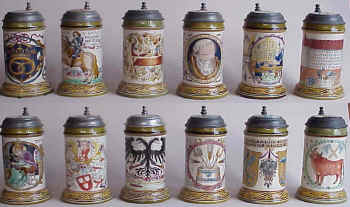 |
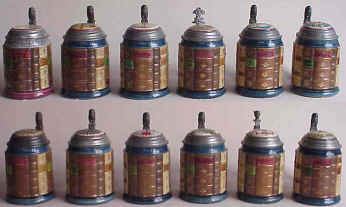 |
| Fig 1. |
Fig 2. |
|
|
Today, stein collectors regard collecting Occupational steins as an exclusive specialty. Desirability is
judged by the following specific characteristics. The stein body is made of porcelain (with a lithophane),
pottery, glass or pewter. (Many collectors have a preference for the porcelain steins.) The presence of an
expression which includes the trade name is desirable, especially when accompanied by the owner's name. The
scarcity of the occupation is also a factor in determining desirability. After ascertaining the scarcity of
the occupation the most important factor in determining the clout of an occupational stein is the manner in
which the occupation is depicted. A stein with a full, wraparound action scene is better than one depicting
a coat-of-arms.
 Another type of Occupational stein (shown at left) is a pewter stein with an occupation portrayed in a cavity or niche in
the side of the body. The name that I have applied to these steins is niche steins. Most of
these steins were manufactured between 1865 and 1890, although many of the top escutcheons are dated in
the 1700's.
Another type of Occupational stein (shown at left) is a pewter stein with an occupation portrayed in a cavity or niche in
the side of the body. The name that I have applied to these steins is niche steins. Most of
these steins were manufactured between 1865 and 1890, although many of the top escutcheons are dated in
the 1700's.
Like their Regimental cousins, Occupational steins are not immune to being reproduced. Reproductions
usually have a full wraparound occupation scene and a portrait of Gambrinus as the lithophane, whereas
Regimental reproductions often have a lithophane of a nude. Most of the reproduction Occupational steins
are marked Rastal; however, some have been seen that were not marked by a manufacturer.
|
|
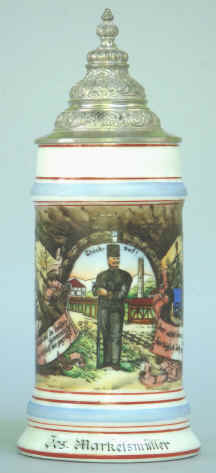 |
| Bergmann -- Miner |
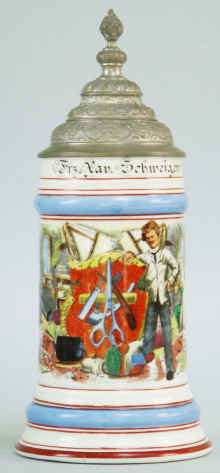 |
| Friseur -- Barber/Hairdresser |
 |
| Schneider -- Tailor |
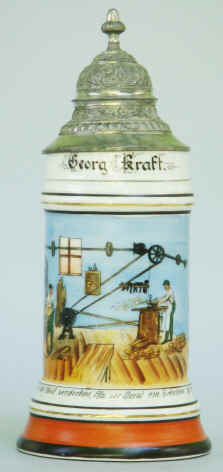 |
| Schreiner -- Joiner, Cabinetmaker |
|

